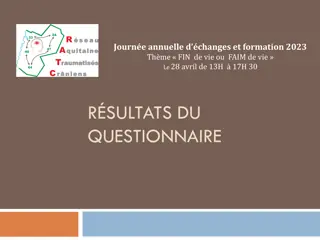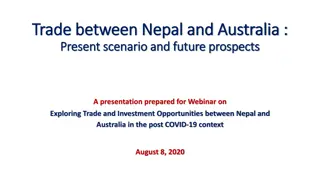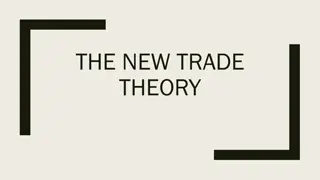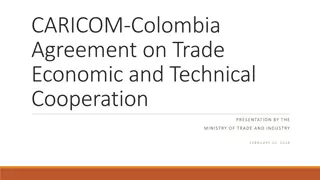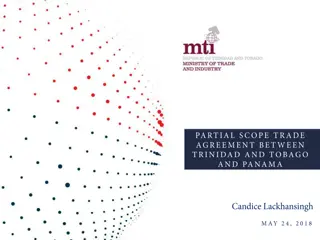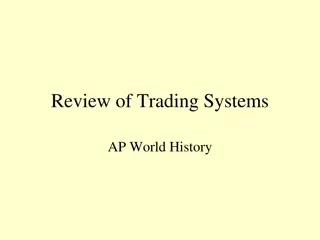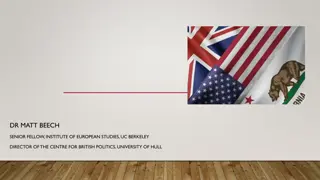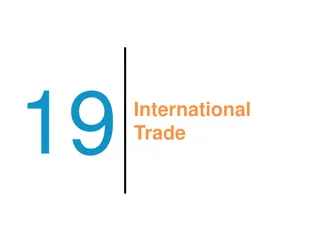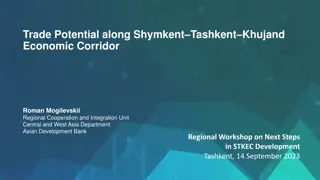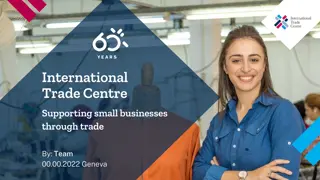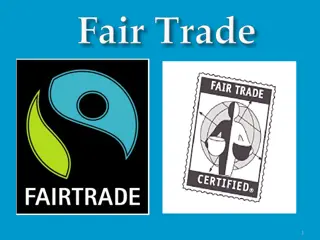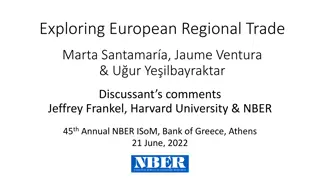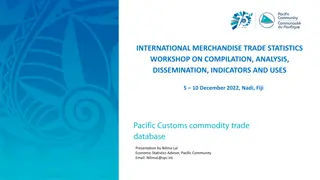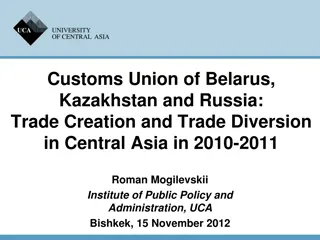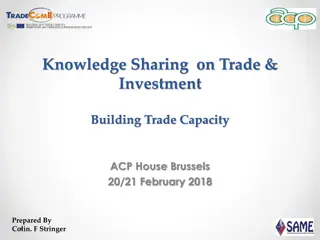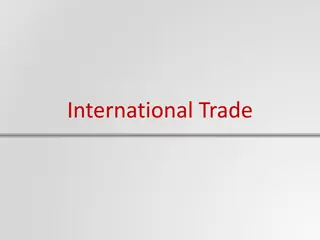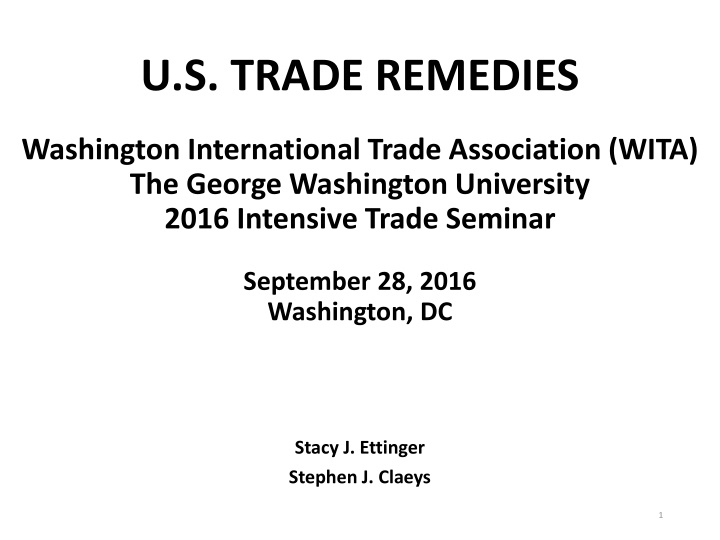
Trade Remedies and U.S. Antidumping and Countervailing Duties
Learn about trade remedies such as antidumping and countervailing duties used to address unfair foreign pricing and government subsidies in the global marketplace. Explore how the U.S. handles dumping investigations, duties assessment, and safeguard actions to protect domestic industries from increased imports.
Download Presentation

Please find below an Image/Link to download the presentation.
The content on the website is provided AS IS for your information and personal use only. It may not be sold, licensed, or shared on other websites without obtaining consent from the author. If you encounter any issues during the download, it is possible that the publisher has removed the file from their server.
You are allowed to download the files provided on this website for personal or commercial use, subject to the condition that they are used lawfully. All files are the property of their respective owners.
The content on the website is provided AS IS for your information and personal use only. It may not be sold, licensed, or shared on other websites without obtaining consent from the author.
E N D
Presentation Transcript
U.S. TRADE REMEDIES Washington International Trade Association (WITA) The George Washington University 2016 Intensive Trade Seminar September 28, 2016 Washington, DC Stacy J. Ettinger Stephen J. Claeys 1
TRADE REMEDIES Unfair foreign pricing and government subsidies distort the free flow of goods and adversely affect competing businesses in the global marketplace. Antidumping (AD) and countervailing (CVD) duty measures may be used to remedy the artificial advantage created by unfair foreign pricing and government subsidies. Safeguard actions may be used to provide relief for domestic industries seriously injured or threatened with serious injury by increased imports. The basics The process The players The disputes 2
ANTIDUMPING MEASURES Dumping involves the actions of companies (in contrast to subsidy cases which involve the actions of governments). Dumping investigations and determinations are country, product, and company-specific. If a company exports a product at a price lower than the price it normally charges on its own home market, it is said to be dumping the product. The difference between the price (or cost) in the home market and the price in the export market is called the dumping margin. The WTO Agreement does not regulate the actions of companies engaged in dumping. Its focus is on how governments can or cannot react to dumping. 3
ANTIDUMPING MEASURES, contd Under the U.S. system, the Commerce Department determines whether dumping is occurring, and if so, the margin of dumping. The International Trade Commission (ITC) determines whether the U.S. industry is materially injured or threatened with material injury by reason of the imports under investigation. If both Commerce and the ITC reach affirmative final determinations, Commerce will instructs Customs and Border Protection (CBP) to assess duties against imports of that product into the United States. The duties are assessed as a percentage of the value of the imports and are equivalent to the dumping margin. 4
COUNTERVAILING DUTY MEASURES Foreign governments subsidize industries when they provide financial assistance to benefit the production, manufacture or exportation of goods. Subsidies can take many forms, such as direct cash payments, credits against taxes, and loans at terms that do not reflect market conditions. The WTO Agreement disciplines the use of subsidies, and regulates the actions countries can take to counter the effects of subsidies. Under the Agreement, a country can use the WTO s dispute-settlement procedure to seek the withdrawal of the subsidy or the removal of its adverse effects. Or the country can initiate a countervailing duty investigation. The amount of subsidies the foreign producer receives from the government is the basis for the subsidy rate by which the subsidy is offset, or "countervailed," through higher import duties. 5
COUNTERVAILING DUTY MEASURES, contd Not all subsidies are countervailable. Injurious subsidies may be countervailed if The government or a public body provides, directly or indirectly, a financial contribution; Which confers a benefit to the recipient; and The subsidy is specific to an enterprise or industry or group of enterprises or industries. (Prohibited subsidies (such as export subsidies) are deemed to be specific. ) Examples of government or public body include a government agency, government bank, or state-owned enterprise. Financial contribution includes a direct transfer of funds, government revenue otherwise due that is foregone, government provision of goods or services (other than general infrastructure), and government purchase of goods. If both Commerce and the ITC reach affirmative final determinations of subsidization and injury, respectively, Commerce will instructs Customs and Border Protection (CBP) to assess countervailing duties against imports of that product into the United States. 6
INJURY TO A DOMESTIC INDUSTRY Under the U.S. system, the ITC determines whether imports that have been found to be dumped or subsidized materially injure or threaten to materially injure a U.S. industry. Material injury is not defined in the WTO Agreements. U.S. law defines material injury as harm which is not inconsequential, immaterial, or unimportant. Determination of injury is based on consideration of the volume of dumped or subsidized imports, the effect of such imports on domestic prices, and the consequent impact on the domestic industry. 7
AD/CVD INVESTIGATIONS THE PROCESS An AD/CVD investigation is started when a petition is filed by or on behalf of the domestic industry. Petitioners must represent at least 25% of domestic production. The petition sets the scope of the investigation. Interested parties may participate in the investigation. U.S. law includes unions as interested parties. During the course of an investigation, the investigating authority/s will collect information, hold a public hearing/s, issue preliminary and final determinations, and audit information provided by certain interested parties. Interested parties have the right to review and comment on information collected during the course of an investigation, meet with the investigating authority/s, and participate in the public hearing/s. 8
SAFEGUARD ACTIONS Safeguards are temporary measures emergency action to limit imports when a surge in imports causes serious injury to a competing domestic industry. Elimination of trade barriers exposes domestic industries to increased competition. Safeguards provide breathing space for industries to adjust to import competition. Safeguards are applied to fairly traded imports i.e., there is no requirement of unfair trade. Unlike AD/CVD measures, safeguard actions normally are not country specific. They apply to all imports from all countries. Types of relief generally include quotas and/or duties. Safeguard measures normally may not last more that 4 years. 9
SAFEGUARD ACTIONS THE PROCESS The ITC conducts safeguard investigations. If the ITC determines that a surge in imports is causing serious injury to a competing domestic industry, it may recommend relief to the President. The President makes the final decision with input from the United States Trade Representative. Relief can be in the form of quotas, tariffs, tariff- rate quotas, or Trade Adjustment Assistance. 10
TRADE REMEDIES - THE PLAYERS Investigating authorities Commerce, ITC CBP Congress The Administration Interested parties 11
TRADE REMEDIES THE DISPUTES Domestic courts WTO dispute settlement Regional trade agreements 12


